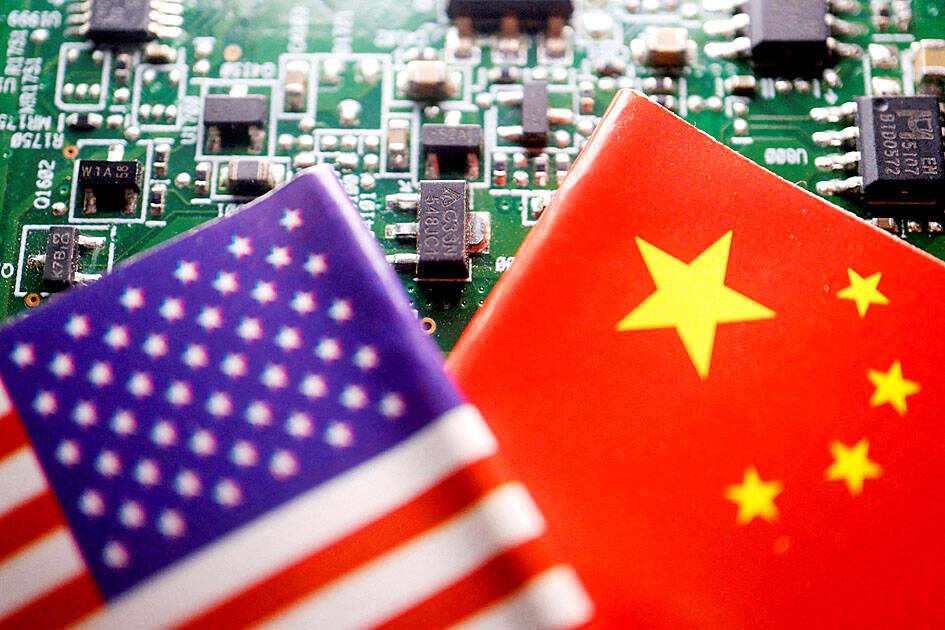US President Joe Biden’s administration is considering further restrictions on China’s access to chip technology used for artificial intelligence (AI), targeting new hardware that is only now making its way into the market, people familiar with the matter said.
The measures being discussed would limit China’s ability to use a cutting-edge chip architecture known as gate all-around (GAA), which is supposed to make semiconductors more powerful and is currently being introduced by chipmakers, the people said.
It is unclear when officials would make a final decision, the people said, adding that they are still determining the scope of a potential rule.

Photo: Reuters
The US’ goal is to make it harder for China to assemble the sophisticated computing systems needed to build and operate AI models, and to cordon off still-nascent technology before it is commercialized, they said.
Companies such as Nvidia Corp, Intel Corp and Advanced Micro Devices Inc — along with manufacturing partners Taiwan Semiconductor Manufacturing Co (台積電) and Samsung Electronics Co — are looking to start mass-producing semiconductors with the GAA design within the next year.
A spokesperson for the US Department of Commerce’s Bureau of Industry and Security, which oversees export controls, declined to comment.
The bureau recently sent a draft GAA rule to what is known as a technical advisory committee, some of the people said.
The panel is composed of industry experts and offers advice on specific technical parameters — a final step in the regulatory process.
However, the rule is not yet finalized, after industry officials criticized the first version as overly broad, the people said.
One person familiar with the matter said the measures would not go as far as an outright ban on GAA chip exports, but instead focus on the technology needed to make them.
There are also early-stage discussions about limiting exports of high-bandwidth memory (HBM) chips, some of the people said.
HBM semiconductors, made by SK Hynix Inc, Micron Technology Inc and others, speed up access to memory, helping bolster AI accelerators. They are used to train AI software — a process that involves bombarding models with information.
It is unclear whether a rule on HBM chips could come together, the people said, adding that the GAA conversation is further along.

CHIP RACE: Three years of overbroad export controls drove foreign competitors to pursue their own AI chips, and ‘cost US taxpayers billions of dollars,’ Nvidia said China has figured out the US strategy for allowing it to buy Nvidia Corp’s H200s and is rejecting the artificial intelligence (AI) chip in favor of domestically developed semiconductors, White House AI adviser David Sacks said, citing news reports. US President Donald Trump on Monday said that he would allow shipments of Nvidia’s H200 chips to China, part of an administration effort backed by Sacks to challenge Chinese tech champions such as Huawei Technologies Co (華為) by bringing US competition to their home market. On Friday, Sacks signaled that he was uncertain about whether that approach would work. “They’re rejecting our chips,” Sacks

Taiwan’s exports soared 56 percent year-on-year to an all-time high of US$64.05 billion last month, propelled by surging global demand for artificial intelligence (AI), high-performance computing and cloud service infrastructure, the Ministry of Finance said yesterday. Department of Statistics Director-General Beatrice Tsai (蔡美娜) called the figure an unexpected upside surprise, citing a wave of technology orders from overseas customers alongside the usual year-end shopping season for technology products. Growth is likely to remain strong this month, she said, projecting a 40 percent to 45 percent expansion on an annual basis. The outperformance could prompt the Directorate-General of Budget, Accounting and

NATIONAL SECURITY: Intel’s testing of ACM tools despite US government control ‘highlights egregious gaps in US technology protection policies,’ a former official said Chipmaker Intel Corp has tested chipmaking tools this year from a toolmaker with deep roots in China and two overseas units that were targeted by US sanctions, according to two sources with direct knowledge of the matter. Intel, which fended off calls for its CEO’s resignation from US President Donald Trump in August over his alleged ties to China, got the tools from ACM Research Inc, a Fremont, California-based producer of chipmaking equipment. Two of ACM’s units, based in Shanghai and South Korea, were among a number of firms barred last year from receiving US technology over claims they have

BARRIERS: Gudeng’s chairman said it was unlikely that the US could replicate Taiwan’s science parks in Arizona, given its strict immigration policies and cultural differences Gudeng Precision Industrial Co (家登), which supplies wafer pods to the world’s major semiconductor firms, yesterday said it is in no rush to set up production in the US due to high costs. The company supplies its customers through a warehouse in Arizona jointly operated by TSS Holdings Ltd (德鑫控股), a joint holding of Gudeng and 17 Taiwanese firms in the semiconductor supply chain, including specialty plastic compounds producer Nytex Composites Co (耐特) and automated material handling system supplier Symtek Automation Asia Co (迅得). While the company has long been exploring the feasibility of setting up production in the US to address